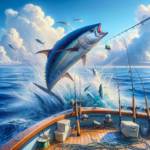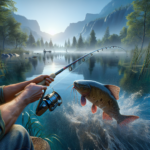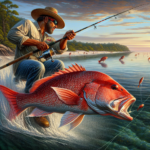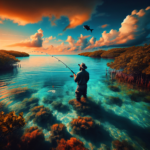Walleye Fishing in the Great Lakes: Michigan and Ohio
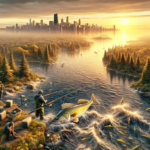
Introduction
Did you know that the Great Lakes hold over 20% of the world’s fresh surface water, and they are home to some of the best walleye fishing spots in North America? Whether you’re a seasoned angler or a novice looking to catch your first walleye, the Great Lakes, particularly in Michigan and Ohio, offer unparalleled opportunities.
This article will delve into the rich history and culture of walleye fishing in the Great Lakes, provide detailed information on the best fishing techniques, and highlight the top fishing spots in Michigan and Ohio. We’ll also cover essential gear, seasonal considerations, and local regulations to ensure you have a successful and enjoyable fishing experience.
Understanding the intricacies of walleye fishing in these regions is crucial for maximizing your catch and ensuring sustainable practices. Whether you’re planning a fishing trip or preparing for a local tournament, this guide will equip you with the knowledge you need.
Background/Context
Historical or Cultural Significance
Walleye fishing has deep roots in the Great Lakes region, particularly in Michigan and Ohio. Historically, Native American tribes relied on walleye as a staple food source. Over the years, walleye fishing has evolved into a popular recreational activity, drawing anglers from across the country. The cultural significance of walleye fishing is evident in local festivals, tournaments, and community events that celebrate this prized fish.
Geographical Overview
The Great Lakes, comprising Lakes Superior, Michigan, Huron, Erie, and Ontario, span over 94,000 square miles. Michigan and Ohio are particularly renowned for their walleye fishing opportunities, with Lake Erie being a hotspot. The region’s climate varies from cold winters to warm summers, creating diverse fishing conditions. The local ecosystem, including abundant forage fish like shad and perch, supports a healthy walleye population.
Key Points/Details
Fishing Techniques
Technique Overview
Walleye fishing techniques vary depending on the season and location. Common methods include trolling, jigging, and casting. Trolling involves dragging lures or bait behind a moving boat, while jigging uses vertical movements to attract fish. Casting involves throwing lures or bait into the water and retrieving them to mimic prey.
When and Where to Use
Trolling is particularly effective in open waters during the summer months when walleye are more dispersed. Jigging works well in colder months when walleye are concentrated in deeper waters. Casting is ideal for targeting walleye near structures like reefs and drop-offs, especially during the spring and fall.
Recommended Gear
- Rods: Medium to medium-heavy action rods.
- Reels: Spinning or baitcasting reels with a smooth drag system.
- Lines: Braided or fluorocarbon lines with a test strength of 10-20 pounds.
- Bait/Lures: Crankbaits, jigs, and live bait like minnows or nightcrawlers.
Species Information
Species Overview
Walleye (Sander vitreus) are known for their elusive nature and excellent table fare. They prefer cooler waters and are often found near structures like reefs, drop-offs, and submerged vegetation. Walleye are most active during low-light conditions, such as dawn and dusk.
Best Practices
To successfully catch walleye, focus on using the right techniques and gear. Trolling with crankbaits or spinner rigs can cover large areas and locate active fish. Jigging with soft plastics or live bait is effective in deeper waters. Pay attention to water temperature and clarity, as walleye are sensitive to changes in their environment.
Location Information
Top Fishing Spots
- Lake Erie (Ohio): Known as the “Walleye Capital of the World,” Lake Erie offers excellent fishing opportunities, particularly around the Western Basin and the islands.
- Saginaw Bay (Michigan): This bay on Lake Huron is famous for its walleye population, with hotspots like the Saginaw River mouth and the inner bay.
- Detroit River (Michigan): A prime location for spring walleye fishing, especially during the annual spawning run.
Regulations and Licenses
Both Michigan and Ohio have specific fishing regulations to ensure sustainable walleye populations. Anglers must obtain a valid fishing license, which can be purchased online or at local retailers. Be aware of size and bag limits, as well as seasonal restrictions. For example, Ohio has a daily bag limit of six walleye per angler on Lake Erie.
Seasonal Considerations
Seasonal Variations
Walleye behavior and fishing conditions change throughout the year. In spring, walleye move to shallow waters for spawning, making them easier to target. Summer sees walleye dispersing into deeper, cooler waters. Fall brings walleye back to shallower areas as they prepare for winter. Winter ice fishing is popular in Michigan and Ohio, with anglers targeting walleye through the ice.
Best Times to Fish
The optimal times for walleye fishing are during the spring and fall when water temperatures are moderate. Early morning and late evening are the best times of day, as walleye are more active during low-light conditions. Night fishing can also be productive, especially during the summer months.
Events and Tournaments
Event Overview
Both Michigan and Ohio host numerous walleye fishing tournaments and events. The Lake Erie Walleye Trail (LEWT) is a popular tournament series in Ohio, attracting anglers from across the region. Michigan’s Saginaw Bay Walleye Club organizes several tournaments throughout the year, including the prestigious Walleye Fest.
Preparation Tips
To prepare for a walleye fishing tournament, ensure your gear is in top condition and practice your techniques. Study the tournament rules and regulations, and pre-fish the area to identify potential hotspots. Pay attention to weather forecasts and water conditions, as these can significantly impact walleye behavior.
Tips and Best Practices
General Tips
- Use a fish finder to locate walleye and identify underwater structures.
- Experiment with different lure colors and sizes to match local forage.
- Maintain a slow and steady retrieve when trolling or casting.
Avoid Common Mistakes
- Overlooking Water Temperature: Walleye prefer cooler waters, so focus on areas with optimal temperatures.
- Ignoring Weather Conditions: Wind and cloud cover can affect walleye behavior, so adjust your techniques accordingly.
- Using the Wrong Gear: Ensure your rods, reels, and lines are suitable for walleye fishing to avoid missed opportunities.
Advanced Techniques
- Slip Bobber Fishing: Effective for targeting suspended walleye in deeper waters.
- Bottom Bouncing: Use a bottom bouncer rig to present bait near the lakebed, where walleye often feed.
- Night Fishing: Utilize glow-in-the-dark lures or lighted bobbers to attract walleye during nighttime hours.
Gear and Equipment Recommendations
Essential Gear
- Medium to medium-heavy action rods
- Spinning or baitcasting reels
- Braided or fluorocarbon lines (10-20 lb test)
- Crankbaits, jigs, and live bait
- Fish finder
Optional Gear/Upgrades
- Electric trolling motor for precise boat control
- Downriggers for deep-water trolling
- Portable ice shelter for winter fishing
Where to Buy or Rent
Local bait and tackle shops in Michigan and Ohio offer a wide range of fishing gear. Online retailers like Bass Pro Shops and Cabela’s also provide extensive selections. For rentals, check with local marinas and outdoor outfitters.
Safety and Conservation
Safety Tips
- Always wear a life jacket when on the water.
- Check weather forecasts before heading out and be prepared for sudden changes.
- Carry a first aid kit and emergency supplies.
Conservation Practices
- Practice catch and release to preserve walleye populations.
- Follow local fishing regulations and size/bag limits.
- Dispose of fishing line and tackle properly to protect wildlife.
Planning Your Trip
Accommodations
There are numerous lodging options near popular fishing spots in Michigan and Ohio. Consider staying at local hotels, motels, or campgrounds. Some marinas also offer cabin rentals for a more immersive fishing experience.
Travel Tips
Plan your route in advance and check for any road closures or construction. If you’re traveling by boat, ensure your vessel is in good condition and equipped with necessary safety gear. Consider hiring a local fishing guide for expert advice and to maximize your chances of success.
Additional Activities
In addition to fishing, the Great Lakes region offers a variety of recreational activities. Explore local hiking trails, visit nearby state parks, or enjoy water sports like kayaking and paddleboarding. These activities make the area ideal for family trips or group outings.
Frequently Asked Questions (FAQs)
What is the best time of year to fish for walleye in the Great Lakes?
The best times are during the spring and fall when water temperatures are moderate, and walleye are more active.
Do I need a fishing license to fish in Michigan and Ohio?
Yes, a valid fishing license is required in both states. Licenses can be purchased online or at local retailers.
What are the most effective lures for walleye fishing?
Crankbaits, jigs, and live bait like minnows or nightcrawlers are highly effective for walleye fishing.
Are there any local fishing tournaments I can participate in?
Yes, both Michigan and Ohio host numerous walleye fishing tournaments. Check local event listings for dates and entry requirements.
Conclusion
Walleye fishing in the Great Lakes, particularly in Michigan and Ohio, offers a rewarding experience for anglers of all skill levels. By understanding the best techniques, gear, and locations, you can maximize your chances of success. Remember to follow local regulations and practice sustainable fishing to preserve these valuable resources for future generations. Whether you’re planning a trip or preparing for a tournament, this guide provides the essential information you need for a successful walleye fishing adventure.
So grab your gear, head to the Great Lakes, and enjoy the thrill of catching walleye in one of North America’s premier fishing destinations!

